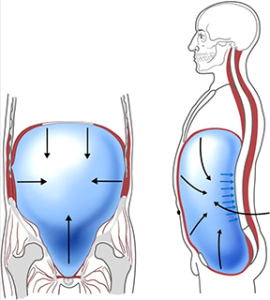Why exercising?
Present way of using our bodies very often does not correspond to activities we have been adapted to during our evolution. This is also one of the reasons for the rapid growth of rehabilitation centers as a consequence of inadequate or insufficient loading. The basic condition for function and structure restoration to maintain mobile system health is adequate load. Exercising offers possibilities to adapt to bigger strength demands. The benefits aren’t only stabilization of muscles, spine, and joints, but also improving health of organs.
I would like to mention the stationary sitting position on a chair when in front of a PC. Paradoxically, all of what I have written so far has been done on one and most of the people can barely avoid working on one either. Yet not so many people realize that work on PC will influence our bodies in a way, that it takes over our concentration from reality to virtual world. If your attention is completely taken by what you see on screen it is not possible to keep an eye on correct posture. Here the grand problem arises: how to support the body in times when the “mind” is completely occupied. It is absolutely against our nature to spend many hours, days, months in the same position. To keep correct posture, it is sufficient to have a common wooden chair together with some pillows. Nobody needs special chairs, which supposed to support your posture. Of course while resting, the half sitting position is OK.
How does exercising come into play? Only resistance training can increase rigidity of our joint connections.
Breathing practise
Diaphragm plays two important roles in the human body: breathing muscle and core and spine stabilization. That is why breathing practice, with diaphragm, should be part of our daily motor habits.
Is it even possible to train or retrain the breathing stereotype, even though it is controlled from the most part unconsciously? Or are you able consciously breathe without lifting shoulders (not overloading upper shoulder blade fixators) and not arch the lower back (not overloading muscles by the transition thoracic and lumbar spine)? Do you even want to breathe in a way that you will stabilize spine and this way get the most benefits of it? Because many don’t know that complaints of certain body aches often disappear with proper breathing techniques. The final answer is then YES, you can teach your brain to use “correct” breathing habits.
What breathing technique is not correct?
Upper breathing: Lifting shoulders and expansion of lower ribs while inhaling. This results in overloading of upper part of trapezius muscle (lifting shoulder blades), spine erectors, deactivating abdominal muscles – in other words: reduction of deep spinal and joint stabilization system activity.
I will describe inhaling “down” and for weight training “strength exhaling” later I will speak about stabilization inhaling and exhaling during one cycle of an exercise.
What correct breathing technique looks like?
Inhaling down: Inhaling into the lower part of abdomen should stabilize both your shoulders and your spine.
Imagine diaphragm establishes a sort of piston compressing the content of abdominal cavity, thereby creating “liquid ball” supporting lumbar spine from the inside. This pressure inside the abdominal cavity activates deep back muscles – rotators and erectors. They have stabilization function, co-creating the muscle corset necessary for spine support. Deep abdominal muscles work as a natural belt, while inhaling these muscles work in the eccentric thus decelerating contraction. That means we flex and extend the muscles at the same time. Other essential muscles involved in deep spine stabilization besides diaphragm are abdominal muscles, muscles around spine and muscles of pelvic floor.
This type of inhaling helps also with prevention of mobility disorders. When practicing the drills of the inhaling technique start with low intensity, slow (performed only 5x,next set after short break ) and long using your nose. During fast breathing with higher number of repetition an unpleasant feeling similar to the one coming up during blowing a balloon might arise. As a beginner start practicing in the lying position best on belly eventually on the back or side (standing position is the most demanding and should be your ultimate goal).
Side note – it is not about having the breath under control all the time. It is handy realizing how you breathe during the day but the breathing drills should be done in the evenings or mornings. The goal is to reprogram breathing habits while resting. An example would be breathing during night, when it should be absolutely common to keep low breathing (to the abdomen = physiological breathing).
Several long calm breaths down to the abdomen before sleep induces relaxation and helps with falling asleep.
While inhaling “down” abdominal muscles are contracted only with small force. It´s adequate activity is connected with light but noticeable tension in groins. Picture a “liquid ball” which during inhaling leans against pelvic floor muscles. Massive abdominal muscles contraction and large pressure generation while inhaling and abdominal muscles in eccentric position would increase risk of inguinal or even umbilical hernia. Even though this is usually the case of heavy lifting or “force exhaling”. This applies especially to hypermobile individuals with less strong ligaments. However, the stronghold of ligaments might be improved to a certain extend. It is recommended to practice stomach inhaling gradually during several weeks using various positions or in combination with limbs movements as progression (easiest lying on belly, more demanding while standing).
Abdomen inhaling goes along with breathing in rest. If you practice any kind of sport with higher performance, you need bigger amount of oxygen. Thereafter the “basic” non-balast breathing is unconsciously enhanced by bigger excursion of chest. Ribs are moving more laterally and chest expands to all directions.

